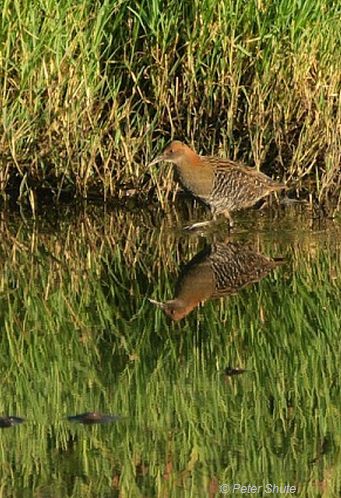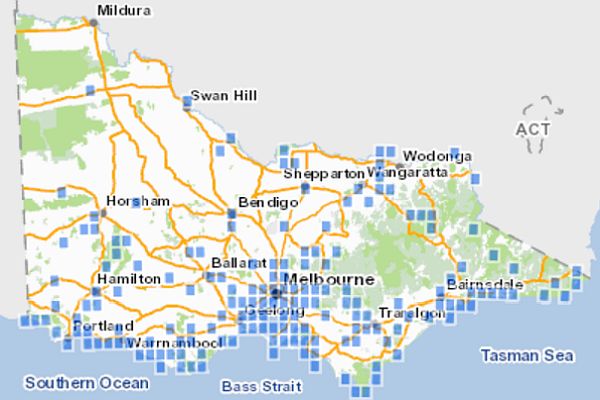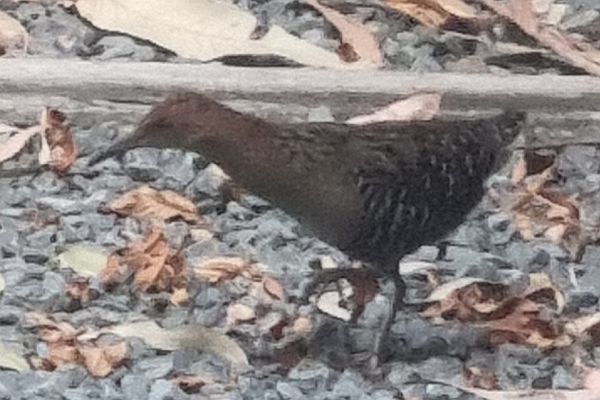Lewin's Rail
Lewin's RailLewinia pectoralis pectoralis | |
|---|---|
| Kingdom: | Animalia |
| Phylum: | Chordata |
| Class: | Aves |
| Order: | Gruiformes |
| Family: | Rallidae |
| Status | |
| World: | Least concern (IUCN 2016) |
| Australia: | Near theatened (Garnett & Crowley 2000) |
| Victoria: | Vulnerable (FFG Threatened List 2024) |
| FFG: | Listed (FFG Act 1988) |

Peter Shute, taken at Altona 2010
The Lewin’s Rail (Lewinia pectoralis pectoralis) is a seldom observed bird inhabiting vegetated wetlands. Sub-species of Lewinia (also referred to as Rallus) occur in Indonesia, Papua New Guinea and Australia.
In Australia there are three recognised sub-species (formally referred to as Rallus);
- Lewinia pectoralis pectoralis - which occurs on the east coast of mainland Australia.
- Lewinia pectoralis brachipus - in Tasmania.
- Lewinia pectoralis clelandi - once occurring in south west Western Australia but now considered extinct (Marchant & Higgins 1993, Simpson & Day 1996; PW 2016, AFD 2024).
Lewin’s Rail is a small to medium sized rail between 20 and 27 cm in length. It has a wingspan ranging from 31 to 35 cm. The top of the head and back of the neck is a chestnut colour with black streaks. Upperparts are black with an olive edge on the feathers giving a mottled and striped appearance. The chin is light grey and the underside of the neck and chest is olive–grey. It has a long, thin bill which is black towards the tip and a reddish tinge towards the base. The abdomen is barred black and white. The legs and feet are grey-brown.

Lewin's Rail Images: Mark Bachmann, Nature Glenelg Trust. Read the story A very unusual “bird in the hand” – A rare encounter with Lewin’s Rail Nature Glenelg Trust Newsletter #52 November 2019.


The Australian subspecies do not vary greatly from each other and are mainly distinguished by size; Rallus brachipus (the Tasmanian sub-species) and Rallus pectoralis clelandi (the Western Australian subspecies – now considered extinct) being slightly larger than Rallus pectoralis pectoralis. The Western Australian sub-species had a darker chestnut colouration on the head and the olive-brown than the eastern sub-species. The Tasmanian sub-species is similar to the eastern mainland species but the colour of head and breast is still more obscured by olive tips to the feathers, and the belly, which is white in the other subspecies (Harrison 1975).
Distribution

Concentrations of records exist around wetlands on the western side of Port Philip Bay in the Williamstown to Altona area, Werribee to Point Wilson area and the Geelong salt works. Wetlands around Western Port Bay also provide important habitat.

Ecology & Habitat
Lewin’s Rail mostly inhabits wetland areas with dense vegetation, including wetlands, farm dams, swamps, saline lakes and river flats where they usually forage around the waters edge in shallow water and close to cover for a variety of aquatic plants and invertebrates (Marchant & Higgins 1993; Blakers et al. 1984). The Lewin’s Rail spends most of the day amongst the dense vegetation and is most active at dawn, dusk and low light, for example cloudy days (Gilbert 1936).
Saucer shaped nests are created amongst the dense vegetation like tussock grasses, reeds and associated vegetation. The nest is situated above the water line with vegetation pulled overtop for cover (Kingsford 1991). Tunnels are created for quick retreat in the dense vegetation (Barnby Smith 1915). The bird will not often fly but prefer to retreat into the vegetation (Marchant & Higgins 1993).

Threats

Lewin’s Rail is a very elusive and hard to observe species which makes it hard to define if populations are declining or if they are presently low (Blakers et al. 1984). There have only been 154 sight records in 149 years of data (SAC 1997). The extinction of the western subspecies Rallus pectoralis clelandi serves as an example of what could possibly happen to other populations within Australia.
Habitat destruction; this is a major threatening process for the species with the occurrence of grazing, removal of wetland plants, drainage of wetlands and fire (SAC 1997). The occurrence of fire in areas of the Lewin’s rail habitat is highly undesirable, because it would change the vegetation structure that the bird requires (SAC 1997).
Habitat fragmentation; this species has shown that it is subject to fragmentation because of unavailable habitat. This is demonstrated with the presence of subspecies on mainland Australia and there is a current possible risk of further fragmentation (Blakers et al. 1984).
Introduced predators; predation by foxes, domestic and feral cats on chicks and adult birds is a major problem for this species (Marchant & Higgins 1993).
Inappropriate subdivision; developments close to wetlands increases the risk of unintended threats such as those above as well as increasing disturbance which can impact on feeding, refuge and breeding conditions.
Climate change; impacts from reduced flows into river systems and wetlands is likely to have an adverse outcome for the Lewin’s Rail through loss of suitable habitat.
Conservation & Management
There has been little direct management of this species in the past, but the retention of habitat for Lewin’s Rail has benefited from wider conservation measures such as creation of conservation reserves containing wetlands. Other activities include;
- Observation of populations to determine behaviour and requirements (Gould 1972; Milledge 1972).
- Captive breeding for research purposes (Barnby Smith 1915).
Suggested management actions
Research and Monitoring
- Gather more information on known populations to establish an accurate data set of population numbers.
- Survey to find new populations and habitat locations.
- Determine if and how far the birds travel.
- Research the habitat size requirement to determine the carrying capacity and area of preservation required.
- Encourage sightings to be recorded to improve on the limited data.
- Monitor threatening processes that may occur at possible habitat sites.
Habitat Protection
- Consider Lewin’s Rail habitat requirements before undertaking fuel reduction burning in proximity to wetlands.
- Encourage private land holders to conserve areas where populations reside.
- Limit slashing to avoid habitat removal near the waters edge.
- Allocate water for environmental flows in sites of known habitat.
Prevent Predation
- Control of feral and domestic cats from killing the birds through increasing cat owner knowledge and capture of feral cats and foxes.
Planning
- Ensure proper municipal planning to prevent habitat destruction and processes that may cause a decline to this species.
Community Interaction
- Inform communities of the habitat requirements through signs or personal contact.
- Improve the knowledge of land holders that have the Lewin’s rail on their property
- Work with conservation groups to have more support for the preservation of the species.
- Interstate cooperation between conservation organisations and environment departments to determine status of the species and manage habitat.
- Create localised plans for the conservation of the local populations.

Lewin's Rail - image taken in the yard of a property near Raglan, Victoria approx. 4 weeks after the Mt Cole bushfire in February 2024 which burnt forest and wetland habitat in the area. Gardens can provide important temporary refuge providing food and shelter when large areas of natural habitat are lost. Image courtesy Cave Hill Creek
References & Links
- AFD (2024) Australian Fanual Directory, Accessed 23/2/2024 https://biodiversity.org.au/afd/taxa/Lewinia_pectoralis/checklist
- Barnby Smith, C. (1915) Pectoral Rails in Captivity, Avicultural Magazine, pg56
- Blakers, M., Davies, S.J.J.F., Reilly, P.N. (1984) The Atlas of Australian Birds, Royal Australasian Ornithologists Union, Melbourne University Press, pg 127.
- Clements, J.F. (2007) The Clements checklist of birds of the world 6th edition, with updates to October 2007, Cornwell University Press.
- DSE (2013) Advisory list of threatened vertebrate fauna in Victoria, Department of Sustainability & Environment, East Melbourne.
- FFG Act (1988) Flora and Fauna Guarantee Act 1988, Department of Environment, Land, Water & Planning, Victoria.
- FFG Threatened List (2024) Department of Energy, Environment and Climate Action (DEECA), Victoria.
- Garnett, S.T. and Crowley G.M. (2000) Action Plan for Australian Birds 2000 – Taxon Summary, Lewin’s Rail]
- Gilbert P.A (1936) Field Notes on Rallus Pectoralis, The Emu, Vol 36, pg72-73
- Gould J. (1972) Handbook to the Birds of Australia, Lansdowne Press, pg 336- 337.
- Harrison C. J. O. (1975) The Australian Subspecies of Lewin’s Rail, Sub-department of Ornithology, British Museum (Natural History), Tring, Hertfordshire, England, The Emu, Vol 75, pg 39-40. CSIRO publishing.The Australian sub-species of Lewin’s Rail (pdf)]
- IUCN (2016) IUCN Red List- Lewin’s Rail BirdLife International. 2016. Accessed 23/2/2024.
- Kingsford R. (1991) Australian Waterbirds, A Field Guide, Kangaroo Press, pg 54.
- Marchant, S. & Higgins, P. J. (ed) (1993) Handbook of Australian, New Zealand and Antarctic Birds, Raptors to Lapwings, Melbourne Oxford University Press, Vol 2, pg 529- 537.
- Milledge, D. (1972) Birds of Maatsuyker Island, Tasmania, The Emu, Vol 72, pg169
- PW (2016 Parks and Wlidlife, Western Australia.
- SAC (1997) Final Recommendation on a nomination for listing: Lewin’s Rail Dryolimnas pectoralis (Nomination No.446). Scientific Advisory Committee, Flora and Fauna Guarantee. Department of Sustainability and Environment: Melbourne
- Simpson and Day (1996) Field guide to the birds of Australia, sixth edition, published by Penguin Books Australia Ltd. 1999.
- VBA (2019) Victorian Biodiversity Atlas, Department of Environment, Land, Water & Planning, Victoria. Accessed 2 November 2019.
More Information
Australasian Bittern - (found in similar habitats)

